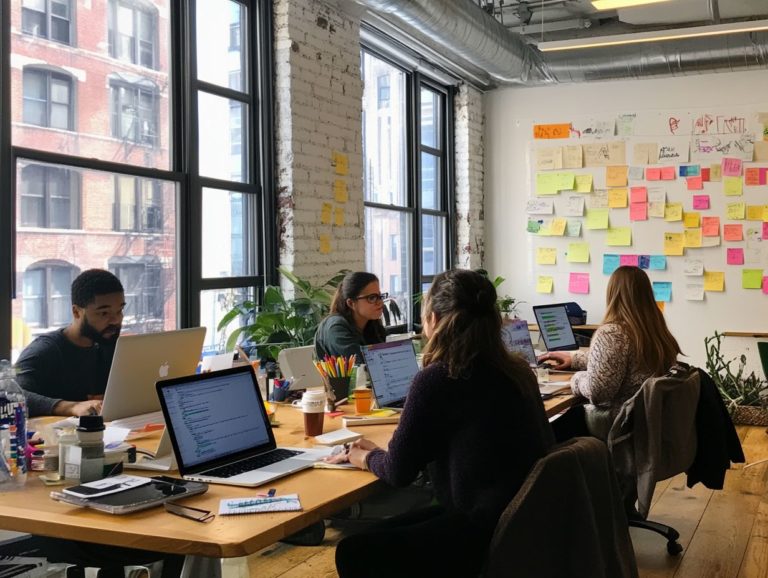Creative Problem Solving Techniques to Master
In a world that s become a labyrinth of complexity and swift change, creative problem-solving stands out as an indispensable skill you need to cultivate.
This article delves into the essence of creative problem-solving, highlighting its advantages over traditional methods. It illustrates how you can apply it effectively across various situations.
You ll discover a suite of innovative tools and techniques, from brainstorming and mind mapping to role-playing and reverse thinking.
We ll tackle common barriers and offer practical tips to elevate your problem-solving abilities. If you re prepared to unleash your creative potential, keep reading!
Contents
- Key Takeaways:
- Understanding Creative Problem Solving
- The Importance of Creative Problem Solving
- Tools and Techniques for Creative Problem Solving
- Ways to Apply Creative Problem Solving
- Overcoming Common Barriers to Creative Problem Solving
- Mastering Creative Problem Solving
- Frequently Asked Questions
- Unlocking Innovative Solutions: What Are Creative Problem-Solving Techniques?
- Exploring Common Techniques: What Are Some Creative Problem-Solving Techniques?
- How to Enhance Your Skills: How Can I Improve My Creative Problem-Solving Skills?
- Reaping the Rewards: What Are the Benefits of Mastering Creative Problem-Solving Techniques?
- Versatility in Application: Can Creative Problem-Solving Techniques Be Applied in Any Situation?
- Incorporating Techniques Daily: How Can I Incorporate Creative Problem-Solving Techniques into My Daily Life?
Key Takeaways:

Creative problem-solving leads to innovative solutions.
Tools like brainstorming and role-playing boost these skills.
Practice using real-life examples to master creative problem-solving.
Address common barriers and challenges for better outcomes.
Understanding Creative Problem Solving
Understanding creative problem-solving is essential for navigating both personal and professional challenges. It enables you to tap into your inner genius through techniques like design thinking and divergent thinking.
This multifaceted approach involves identifying problems and exploring various avenues for solutions while overcoming thinking habits that might inhibit your creativity.
By leveraging creative tools and structured methodologies, you can effectively address complex issues. This generates innovative solutions that offer substantial benefits across different contexts.
Defining the Process and its Benefits
Defining the process of creative problem-solving means recognizing its key techniques and understanding the benefits it offers. It fosters innovation and effective solutions across various domains.
Among these techniques, brainstorming stands out as a fundamental approach. It encourages you to generate a wealth of ideas without judgment, paving the way for unconventional solutions to surface.
The Six Thinking Hats method also promotes parallel thinking. It allows you and your team to assess problems from multiple perspectives, ultimately enhancing your decision-making process.
SWOT analysis provides a structured framework for identifying strengths, weaknesses, opportunities, and threats. This can illuminate pathways for resolving both personal and professional challenges.
By utilizing these methodologies, you not only enhance idea generation but also improve collaboration. This cultivates a culture of innovation that leads to more comprehensive and effective solutions.
The Importance of Creative Problem Solving
The significance of creative problem-solving truly cannot be overstated. It equips you and your team with essential tools to navigate challenges in a constantly changing landscape.
By embracing this approach, you can tackle challenges with fresh ideas and exciting solutions, turning potential setbacks into opportunities for growth.
How it Differs from Traditional Approaches
Creative problem-solving sets itself apart from traditional methods by placing a premium on divergent thinking. This approach enables you to explore a broader spectrum of potential solutions.
Unlike conventional methods that follow rigid processes, this innovative strategy embraces flexibility and open-mindedness. Engaging in creative problem-solving encourages you to think outside the box and challenge your preconceived notions.
By breaking free from functional fixedness, where you might get stuck on familiar solutions, you open yourself up to a treasure trove of alternative ideas that may not initially seem practical. This shift in mindset cultivates adaptability and can lead to groundbreaking innovations across various fields, turning challenges into remarkable opportunities for growth.
Tools and Techniques for Creative Problem Solving

A diverse array of tools and techniques is imperative for mastering creative problem-solving.
By leveraging these resources, you and your team can unlock your creativity. This helps craft innovative solutions to the most intricate challenges.
Brainstorming and Mind Mapping
Brainstorming and mind mapping are invaluable tools for you. They facilitate the generation of ideas by enabling you to visually organize your thoughts and explore a plethora of possibilities.
Creating an environment where you and your participants can freely express your ideas enhances group dynamics. In your brainstorming sessions, it s crucial to avoid judgment; every contribution is welcome, regardless of how unconventional it may appear.
By shifting your focus to positive language, you inspire active engagement from everyone involved. Complementing this with mind mapping allows you to see connections between ideas, effectively elevating the problem-solving process.
This clear visualization not only makes it easier for you to identify innovative solutions but also fosters a collaborative spirit within your team.
Role Playing and Visualization
Role playing and visualization are powerful techniques in creative problem-solving. They can help you break free from fixed ways of thinking and discover fresh perspectives.
By immersing yourself in different roles, you can experience scenarios from varied viewpoints. This fosters a deeper sense of empathy and understanding.
For instance, in a workplace setting, engaging in role-playing exercises can simulate challenging conversations or customer interactions. This gives you the chance to practice your responses and build rapport with colleagues.
In personal relationships, employing visualization techniques allows you to imagine the feelings of others. As a parent, for example, you might visualize your child’s perspective during disciplinary moments, guiding you toward a more considerate approach.
Both methods encourage a collaborative mindset and enhance your problem-solving skills across diverse situations.
Reverse Thinking and Random Stimulus
Reverse thinking and the use of random stimuli are keys to unlocking creative problem-solving. They spark fresh ideas and defy conventional thought patterns.
By encouraging you to examine issues from an entirely different perspective, reverse thinking dismantles barriers. It cultivates a mindset receptive to unconventional solutions.
Engaging with random words or unexpected triggers can serve as a powerful catalyst for your imagination. This prompts you to connect seemingly unrelated ideas that might otherwise go unnoticed.
This technique infuses a sense of playfulness into your brainstorming sessions, inviting you to explore possibilities you may have previously overlooked. The surprises that arise can lead to breakthrough insights, transforming challenges into unique opportunities for growth.
Ways to Apply Creative Problem Solving
Applying creative problem-solving in real life demonstrates its effectiveness through various examples and case studies. These instances inspire and provide a roadmap for navigating challenges with ingenuity.
Examples and Case Studies

Numerous examples and case studies illustrate the extraordinary impact of creative problem-solving in generating innovative solutions across various fields.
Take technology, for instance. A notable case involved a team of engineers at a leading software company who harnessed brainstorming sessions to tackle a significant software glitch. By fostering an environment that encouraged out-of-the-box thinking, they resolved the issue faster than expected and crafted an enhanced version of the software that significantly improved user experience.
In the healthcare sector, a hospital embraced design thinking workshops, enabling their staff to reimagine patient flow. This initiative led to reduced wait times and heightened patient satisfaction.
These examples highlight that employing creative techniques does more than merely address immediate problems; it paves the way for sustained benefits and innovation.
Overcoming Common Barriers to Creative Problem Solving
Overcoming common barriers to creative problem-solving is essential for cultivating an environment that promotes innovation. By addressing these obstacles, you can significantly reduce fixed ways of thinking and navigate other challenges that may hinder your creativity.
Identifying and Addressing Challenges
Identifying and addressing challenges within your creative problem-solving process is essential for elevating innovation and nurturing emotional intelligence in your team.
By recognizing these obstacles, you enable yourself and your colleagues to navigate complex situations with greater ease. This fosters a collaborative environment. When team members feel comfortable sharing their struggles, they cultivate a deeper understanding of each other’s perspectives and strengths. This openness builds better teamwork and helps creative solutions emerge.
Emotional intelligence is key in this dynamic; it equips you with the necessary tools to manage conflicts and promote positive interactions. By confronting challenges directly, your team creates fertile ground for heightened creativity and productivity.
Mastering Creative Problem Solving
To master creative problem solving, you can unlock your potential by embracing specific tips and strategies designed to enhance your creative thinking skills. By doing so, you can achieve remarkable success across various contexts.
Tips and Strategies for Success
To excel in creative problem solving, embrace a range of tips and strategies that promote exploration and innovative thinking. This journey begins with creating an environment that prioritizes curiosity, where you and your team feel comfortable sharing unique perspectives.
Integrating diverse techniques like brainstorming (a group activity where people share ideas openly), mind mapping, and role-playing can transform the creative process into a dynamic and interactive experience. Emphasizing adaptability is crucial, as it enables your team to pivot when faced with unforeseen challenges. This allows you to navigate obstacles without losing momentum.
Encouraging collaboration among individuals with varied skill sets and backgrounds enriches outcomes and nurtures a vibrant culture of creativity. This ultimately leads to groundbreaking solutions that might otherwise remain hidden in a more homogeneous setting.
Watch this video to learn more about creative problem-solving techniques.
Frequently Asked Questions

Unlocking Innovative Solutions: What Are Creative Problem-Solving Techniques?
Creative problem-solving techniques are methods and strategies used to find innovative solutions to complex problems. Mastering these techniques helps individuals and teams think outside the box, overcome challenges, and develop unique and effective solutions.
Exploring Common Techniques: What Are Some Creative Problem-Solving Techniques?
Common creative problem-solving techniques include:
- Brainstorming
- Mind mapping
- The 5 Whys technique
- The SCAMPER method
- The Fishbone diagram
These techniques help individuals and teams approach problems from different angles and come up with diverse solutions.
How to Enhance Your Skills: How Can I Improve My Creative Problem-Solving Skills?
Improve your creative problem-solving skills by practicing brainstorming regularly, challenging yourself to find multiple solutions for a problem, and experimenting with different techniques. Seek feedback from others. Being open-minded, curious, and willing to take risks also enhances your skills.
Reaping the Rewards: What Are the Benefits of Mastering Creative Problem-Solving Techniques?
Mastering creative problem-solving techniques offers many benefits, including:
- Finding unique solutions to complex problems
- Improving communication and collaboration within a team
- Boosting confidence in decision-making
- Fostering creativity and innovation
Versatility in Application: Can Creative Problem-Solving Techniques Be Applied in Any Situation?
Yes, creative problem-solving techniques can be applied in any situation where a problem needs to be solved. They are useful in both personal and professional settings and can address any type of problem, from simple to complex.
Incorporating Techniques Daily: How Can I Incorporate Creative Problem-Solving Techniques into My Daily Life?
You can incorporate creative problem-solving techniques into your daily life by being mindful of your thought process when facing challenges, practicing techniques regularly, and seeking opportunities to apply them. Engage in activities that stimulate creativity, such as reading, art, or trying new experiences.
Start applying these techniques today and see the difference in your problem-solving skills!






